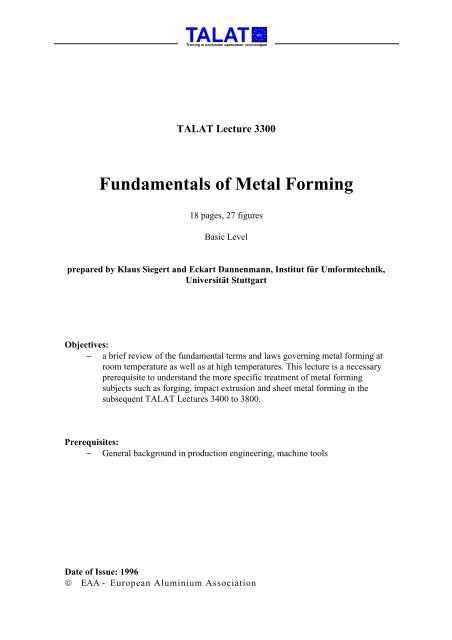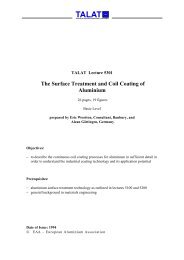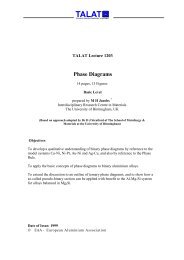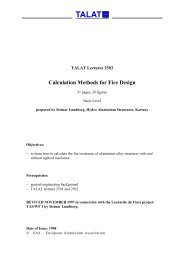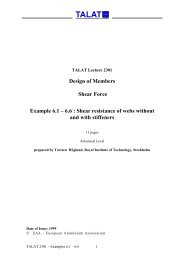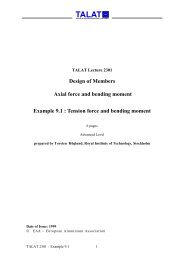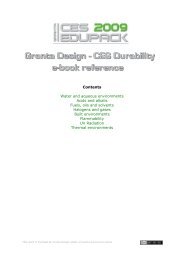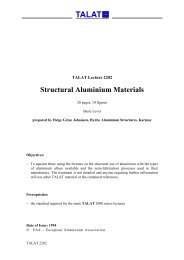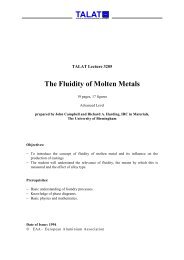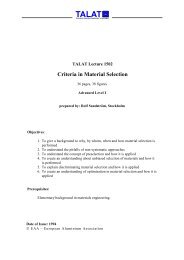TALAT lecture 3300: fundamentals of metal forming - CORE-Materials
TALAT lecture 3300: fundamentals of metal forming - CORE-Materials
TALAT lecture 3300: fundamentals of metal forming - CORE-Materials
Create successful ePaper yourself
Turn your PDF publications into a flip-book with our unique Google optimized e-Paper software.
<strong>TALAT</strong> Lecture <strong>3300</strong><br />
Fundamentals <strong>of</strong> Metal Forming<br />
18 pages, 27 figures<br />
Basic Level<br />
prepared by Klaus Siegert and Eckart Dannenmann, Institut für Umformtechnik,<br />
Universität Stuttgart<br />
Objectives:<br />
− a brief review <strong>of</strong> the fundamental terms and laws governing <strong>metal</strong> <strong>forming</strong> at<br />
room temperature as well as at high temperatures. This <strong>lecture</strong> is a necessary<br />
prerequisite to understand the more specific treatment <strong>of</strong> <strong>metal</strong> <strong>forming</strong><br />
subjects such as forging, impact extrusion and sheet <strong>metal</strong> <strong>forming</strong> in the<br />
subsequent <strong>TALAT</strong> Lectures 3400 to 3800.<br />
Prerequisites:<br />
− General background in production engineering, machine tools<br />
Date <strong>of</strong> Issue: 1996<br />
© EAA - European Aluminium Association
<strong>3300</strong> Fundamentals <strong>of</strong> Metal Forming<br />
Table <strong>of</strong> Contents<br />
<strong>3300</strong> Fundamentals <strong>of</strong> Metal Forming ............................................................2<br />
3301 Introduction................................................................................................... 3<br />
3301.01 Definition <strong>of</strong> Forming..............................................................................3<br />
3302 Terms for Classifying Forming Processes .................................................. 4<br />
3302.01 Classification by State <strong>of</strong> Stress (Figure 3302.01.01)..............................4<br />
3302.02 Classification by Type <strong>of</strong> Raw Material (Figure 3302.02.01) .................4<br />
3302.03 Classification by Forming Temperature...................................................5<br />
3302.04 Classification by Methods <strong>of</strong> Induction <strong>of</strong> Forces into the Work-Piece..5<br />
3303 Characteristic Values and Basic Laws <strong>of</strong> Metal Forming......................... 6<br />
3303.01 Flow Stress...............................................................................................6<br />
3303.02 Plastic Strain, Rate and Acceleration.......................................................7<br />
Logarithmic (True) Plastic Strain....................................................................... 7<br />
Logarithmic Strain in Upsetting ......................................................................... 7<br />
Law <strong>of</strong> Volume Constancy .................................................................................. 8<br />
Plastic Strain Rate .............................................................................................. 8<br />
Plastic Strain Acceleration ................................................................................. 9<br />
3303.03 Plastic Flow under Combined Stresses....................................................9<br />
Criteria for Plastic Flow..................................................................................... 9<br />
Maximum Shear Stress Hypothesis................................................................... 10<br />
Mises Flow Criterion........................................................................................ 11<br />
Yield Criteria for Plane Stress (Yield Locus) ................................................... 12<br />
3303.04 Law <strong>of</strong> Plastic Flow ...............................................................................12<br />
3303.05 Flow Curves.............................................................................................13<br />
General Definition <strong>of</strong> the Flow Curve .............................................................. 13<br />
Flow Curves at Room Temperature.................................................................. 13<br />
Flow Curves at Elevated Temperatures............................................................ 14<br />
3303.06 Average Flow Stress ..............................................................................16<br />
3303.07 Energy Considerations ...........................................................................16<br />
Forming Energy................................................................................................ 16<br />
Heat Development during Forming.................................................................. 17<br />
Literature/References ............................................................................................. 18<br />
List <strong>of</strong> Figures.......................................................................................................... 18<br />
<strong>TALAT</strong> <strong>3300</strong> 2
3301 Introduction<br />
3301.01 Definition <strong>of</strong> Forming<br />
The general description given in Figure 3301.01.01 defines <strong>metal</strong> <strong>forming</strong> by plastic<br />
deformation and distinguishes it from other <strong>forming</strong> and shaping processes like casting<br />
and machining.<br />
K.Siegert<br />
alu<br />
Training in Aluminium Application Technologies<br />
Definition <strong>of</strong> Forming<br />
Forming is a fabrication process for solid substances by controlled<br />
plastic deformation in order to obtain alterations <strong>of</strong>:<br />
- the form,<br />
- the material properties and/or<br />
- the surface properties,<br />
whereby the mass and material continuum remain unchanged.<br />
Definition <strong>of</strong> Forming<br />
<strong>TALAT</strong> <strong>3300</strong> 3<br />
3301.01.01
3302 Terms for Classifying Forming Processes<br />
• Classification by State <strong>of</strong> Stress<br />
• Classification by Type <strong>of</strong> Raw Material<br />
• Classification by Forming Temperature<br />
• Classification by Methods <strong>of</strong> Induction <strong>of</strong> Forces into the Work-Piece<br />
3302.01 Classification by State <strong>of</strong> Stress (Figure 3302.01.01)<br />
alu<br />
Training in Aluminium Application Technologies<br />
Terms for classifying the <strong>forming</strong> process:<br />
Classification by State <strong>of</strong> Stress<br />
Pressure Forming<br />
Tension-Compression<br />
Forming<br />
Tension Forming<br />
Bend Forming<br />
Shear Forming<br />
DIN 8583<br />
DIN 8584<br />
DIN 8585<br />
DIN 8586<br />
DIN 8587<br />
Classifying the Forming Process by State <strong>of</strong> Stress<br />
<strong>TALAT</strong> <strong>3300</strong> 4<br />
Rolling, Open-Die Forming,<br />
Die Forming, Indenting,<br />
Pressing Through<br />
Drawing, Deep Drawing,<br />
Collar Forming, Compressing,<br />
Upset Bulging<br />
Stretch Reducing, Bulge Forming,<br />
Stretch Forming<br />
Bending with Linear Tool Movement,<br />
Bending with Rotating Tool Movement<br />
Shear Displacement, Twisting<br />
3302.01.01<br />
3302.02 Classification by Type <strong>of</strong> Raw Material (Figure 3302.02.01)<br />
alu<br />
Training in Aluminium Application Technologies<br />
Terms for classifying the <strong>forming</strong> process:<br />
Type <strong>of</strong> Raw Material<br />
Sheet Forming<br />
The raw material consists <strong>of</strong> flat parts <strong>of</strong> constant thickness.<br />
The parts produced have a three-dimensional form with<br />
approximately constant wall thickness ( ≈ raw material thickness).<br />
Bulk Forming<br />
Raw parts are three-dimensional.<br />
The parts produced are also three-dimensional but <strong>of</strong>ten have<br />
very different wall thicknesses and/ or cross-sections.<br />
Classifying the Forming Process by<br />
Types <strong>of</strong> Raw <strong>Materials</strong><br />
3302.02.01
3302.03 Classification by Forming Temperature<br />
(Figure 3302.03.01)<br />
alu<br />
Training in Aluminium Application Technologies<br />
Terms for classifying the <strong>forming</strong> process:<br />
Forming Temperature<br />
Cold Forming<br />
Process in which the work-piece is not heated before <strong>forming</strong>,<br />
but instead formed at room temperature.<br />
Warm Forming<br />
ϑ = ϑRoom (ca. 20° C )<br />
Process in which the work-piece is heated to an elevated temperature<br />
higher than room temperature before <strong>forming</strong>.<br />
ϑ > ϑ Room (ca. 20° C )<br />
Classifying the Forming Process by<br />
Forming Temperature<br />
<strong>TALAT</strong> <strong>3300</strong> 5<br />
3302.03.01<br />
3302.04 Classification by Methods <strong>of</strong> Induction <strong>of</strong> Forces into the Work-Piece<br />
(Figure 3302.04.01)<br />
alu<br />
Training in Aluminium Application Technologies<br />
Terms for classifying the <strong>forming</strong> process:<br />
Methods <strong>of</strong> Applying Force<br />
Process with Indirect Force Application<br />
(Deep Drawing)<br />
K. Siegert<br />
FN<br />
Forming Zone<br />
F St<br />
Bending Zone<br />
Force Transmission Zone<br />
Force Induction Zone<br />
Classifying the Forming Process by<br />
Methods <strong>of</strong> Applying Force<br />
Process with Direct Force Application<br />
(Upsetting) F<br />
F<br />
3302.04.01
3303 Characteristic Values and Basic Laws <strong>of</strong> Metal Forming<br />
• Flow Stress<br />
• Plastic Strain, Rate and Acceleration<br />
• Plastic Flow under Combined Stresses<br />
• Law <strong>of</strong> Plastic Flow<br />
• Flow Curves<br />
• Average Flow Stress<br />
• Energy Considerations<br />
3303.01 Flow Stress<br />
(Figure 3303.01.01)<br />
alu<br />
Training in Aluminium Application Technologies<br />
Characteristic Values, Basic Laws<br />
Flow Stress<br />
The flow stress (resistance to plastic deformation) <strong>of</strong> a<br />
material is the stress required to initiate or continue<br />
plastic deformation under uniaxial state <strong>of</strong> stress.<br />
Flow stress<br />
(true stress)<br />
By comparison<br />
(technical stress)<br />
Conversion:<br />
with<br />
one obtains<br />
F<br />
k f<br />
A<br />
=<br />
σ = F<br />
A 0<br />
ε = ( l−l )/ l 0 0<br />
= σε ( + 1)<br />
k f l<br />
<strong>TALAT</strong> <strong>3300</strong> 6<br />
A<br />
A 0<br />
F<br />
l 0<br />
l<br />
Definition <strong>of</strong> Flow Stress 3303.01.01<br />
F
3303.02 Plastic Strain, Rate and Acceleration<br />
Logarithmic (True) Plastic Strain<br />
(Figure 3303.02.01)<br />
logarithmic (or true) strain dϕ<br />
=<br />
l<br />
∫<br />
l0<br />
ε = = − ∫ = −<br />
dl<br />
1<br />
l1 l0<br />
l1<br />
1.<br />
l l l<br />
alu<br />
Training in Aluminium Application Technologies<br />
l<br />
l 0 0<br />
⎛ l ⎞ 1<br />
⎜ ⎟ = ( ε + 1)<br />
⎝ l ⎠<br />
0<br />
0<br />
ϕ l = ln( ε + 1)<br />
Logarithmic (True) Strain<br />
The logarithmic strain ϕ (true strain; degree <strong>of</strong> deformation)<br />
is a measure <strong>of</strong> the permanent (plastic) deformation<br />
<strong>TALAT</strong> <strong>3300</strong> 7<br />
0<br />
dl<br />
l<br />
1<br />
dl<br />
l1<br />
ϕ l = = lnl1− lnl0 = ln .<br />
l<br />
l<br />
As opposed to this, elongation<br />
(relative deformation)<br />
Conversion:<br />
with<br />
one obtains<br />
Logarithmic Strain in Upsetting<br />
(Figure 3303.02.02)<br />
Cuboid<br />
Circular<br />
Cylinder<br />
h 0<br />
alu<br />
Training in Aluminium Application Technologies<br />
0<br />
dl<br />
dε<br />
=<br />
l<br />
0<br />
Logarithmic (True) Strain<br />
l 1<br />
dl<br />
2<br />
l<br />
dl<br />
2<br />
Logarithmic Strain in Upsetting<br />
h0<br />
b 0<br />
l 0<br />
r 0<br />
h1<br />
h 1<br />
b 1<br />
r 1<br />
l 0<br />
F<br />
h<br />
ϕ h =<br />
h<br />
b<br />
ϕ b<br />
b<br />
l<br />
ϕ l<br />
l<br />
⎛ ⎞<br />
⎜ ⎟<br />
⎝ ⎠<br />
= ⎛ ⎞<br />
⎜ ⎟<br />
⎝ ⎠<br />
= ⎛<br />
1 ln<br />
0<br />
1 ln<br />
0<br />
⎞ 1 ln⎜<br />
⎟<br />
⎝ ⎠<br />
F<br />
3303.02.01<br />
h<br />
ϕ h =<br />
h<br />
r<br />
ϕr ϕt<br />
r<br />
⎛ ⎞<br />
⎜ ⎟<br />
⎝ ⎠<br />
= ⎛<br />
1 ln<br />
0<br />
⎞ 1 ln⎜<br />
⎟ =<br />
⎝ ⎠<br />
Logarithmic Strain in Upsetting 3303.02.02<br />
l 1<br />
0<br />
0<br />
A 0<br />
A<br />
A 1
Law <strong>of</strong> Volume Constancy<br />
(Figure 3303.02.03)<br />
Taking the logarithms<br />
<strong>of</strong> both sides:<br />
or:<br />
alu<br />
Training in Aluminium Application Technologies<br />
h 0<br />
Law <strong>of</strong> Volume Constancy<br />
⎛ h ⎞ 1 b1<br />
l1<br />
ln⎜ ⎟ + ln ln 0<br />
⎝ h ⎠ b l<br />
⎛ ⎞<br />
⎜ ⎟ +<br />
⎝ ⎠<br />
⎛<br />
V=h1⋅b1⋅ l1 = h0⋅b0⋅l0 ⎛ h ⎞ 1 b1<br />
l1<br />
⎜ ⎟ ⋅ 1<br />
⎝ h0<br />
⎠ b0<br />
l0<br />
⎞<br />
⎜ ⎟ =<br />
⎝ ⎠<br />
⎛ ⎞<br />
⎜ ⎟ ⋅<br />
⎝ ⎠<br />
⎛ ⎞<br />
⎜ ⎟ =<br />
⎝ ⎠<br />
<strong>TALAT</strong> <strong>3300</strong> 8<br />
b 0<br />
0<br />
l 0<br />
h 1<br />
Assuming that during <strong>forming</strong> the volume <strong>of</strong> a cuboid remains constant,<br />
the following equation is valid for a homogeneous compression:<br />
so that:<br />
Plastic Strain Rate<br />
(Figure 3303.02.04)<br />
0<br />
0<br />
b 1<br />
ϕ + ϕ + ϕ = 0 or ϕ = 0<br />
h h h<br />
∑<br />
Law <strong>of</strong> Volume Constancy 3303.02.03<br />
·<br />
The true strain rate or logarithmic strain rate ϕ is the derivative <strong>of</strong> the<br />
logarithmic strain (true strain) ϕ with time t:<br />
From the law <strong>of</strong> volume constancy one obtains:<br />
. . .<br />
ϕh + ϕb + ϕl = 0<br />
.<br />
Σϕ = 0<br />
·<br />
One has to differentiate between the strain rate ϕ and the<br />
tool speed vwz. For a homogeneous compression where<br />
h = instantaneous height <strong>of</strong> the material being compressed,<br />
the following relation is valid:<br />
alu<br />
Training in Aluminium Application Technologies<br />
Plastic Strain Rate<br />
(True strain rate)<br />
ϕ<br />
ϕ = d<br />
dt<br />
ϕ = vwz<br />
h<br />
Plastic Strain Rate (True Strain Rate)<br />
l 1<br />
3303.02.04
Plastic Strain Acceleration<br />
(Figure 3303.02.05)<br />
<br />
The plastic strain acceleration ϕ is the derivative<br />
<br />
<strong>of</strong> the plastic strain rate ϕ with time t:<br />
alu<br />
Training in Aluminium Application Technologies<br />
Plastic Strain Acceleration<br />
& & ϕ<br />
ϕ = d<br />
dt<br />
<strong>TALAT</strong> <strong>3300</strong> 9<br />
Forming Strain Acceleration 3303.02.05<br />
3303.03 Plastic Flow under Combined Stresses<br />
Criteria for Plastic Flow<br />
(Figure 3303.03.01)<br />
alu<br />
Training in Aluminium Application Technologies<br />
Criteria for Plastic Flow<br />
Criteria for plastic flow describe the requirements<br />
which must be fulfilled in order for plastic deformation to<br />
occur under a multiaxial state <strong>of</strong> stress.<br />
The requirements for flow are met when an equivalent<br />
stress, σv , derived from the multiaxial stress state,<br />
equals the flow stress kf: σv = k f<br />
In the <strong>forming</strong> technology, two types <strong>of</strong> flow hypothesis<br />
are used to derive the comparative stress σv :<br />
-the shear stress hypothesis according to TRESCA<br />
-the <strong>forming</strong> energy hypothesis according to v. MISES<br />
Criteria for Plastic Flow 3303.03.01
Maximum Shear Stress Hypothesis<br />
(Figure 3303.03.02, Figure 3303.03.03, Figure 3303.03.04)<br />
Flow occurs when the maximum shear stress τmax reaches a value<br />
characteristic for the material, the so-called shear yield stress k:<br />
alu<br />
Training in Aluminium Application Technologies<br />
τmax = k .<br />
Based on the stresses ( σ1 > σ2 > σ3 ) in the MOHR stress circle,<br />
the following equations can be derived:<br />
τ<br />
τmax =<br />
1<br />
2 ( σ1 − σ3 ) = k<br />
1<br />
τmax = ( σmax − σmin ) = k<br />
2<br />
alu<br />
Training in Aluminium Application Technologies<br />
Shear Stress Hypothesis (1)<br />
σ3<br />
= σmin<br />
<strong>TALAT</strong> <strong>3300</strong> 10<br />
σ2<br />
τmax<br />
(=k)<br />
Shear Stress Hypothesis (1)<br />
Shear Stress Hypothesis (2)<br />
For a uniaxial state <strong>of</strong> tensile stress ( σ1 = σmax , σ2 = σ3 = σmin = 0 ),<br />
the following relationship is valid:<br />
τ<br />
σmax - σmin = σ1 = 2k<br />
and ( definition <strong>of</strong> flow stress )<br />
σ1 = k f .<br />
Considering the flow conditions ( σv = k f ), one<br />
obtains:<br />
σv = k f = σmax - σmin.<br />
σ2 = σ3 = 0<br />
Thus, flow starts when the difference between the largest and<br />
smallest principal normal stresses equals the flow stress.<br />
τmax= k<br />
σ1 = σmax<br />
σ1<br />
σ<br />
3303.03.02<br />
Shear Stress Hypothesis (2) 3303.03.03<br />
σ
alu<br />
Training in Aluminium Application Technologies<br />
Mises Flow Criterion<br />
(Figure 3303.03.05)<br />
alu<br />
Training in Aluminium Application Technologies<br />
Shear Stress Hypothesis (3)<br />
According to the shear stress theory, the<br />
comparative deformation strain is equal to the<br />
largest value <strong>of</strong> the logarithmic deformation strain:<br />
( )<br />
ϕ ϕ , ϕ , ϕ .<br />
g = 1 2 3<br />
ϕg is the principal logarithmic (or true) strain.<br />
Shear Stress Hypothesis (3)<br />
Distortion Energy (von-Mises) Theory<br />
<strong>TALAT</strong> <strong>3300</strong> 11<br />
max<br />
3303.03.04<br />
Flow sets in when the elastic distortion energy for changing the form exceeds a criterical value.<br />
If σ1 > σ2 > σ3, then the comparative stress is given by<br />
σ v σ σ σ σ σ σ<br />
f k<br />
1<br />
= = 1− 2 + 2 − 3 + 3 − 1<br />
2<br />
Using the average stress<br />
1<br />
σ m = ( σ1+ σ 2 + σ 3)<br />
3<br />
one obtains<br />
2<br />
2<br />
( ) ( ) ( )<br />
3<br />
σ = k = σ − σ + σ − σ + σ −σ<br />
v f 1 m 2 m 3 m<br />
2<br />
2<br />
2<br />
( ) ( ) ( )<br />
Then, according to the distortion energy theory, the comparative deformation strain becomes<br />
2 2 2 2<br />
ϕv = ( ϕ1+ ϕ2+ ϕ3)<br />
.<br />
3<br />
2<br />
2<br />
.<br />
.<br />
Distortion Energy Hypothesis (v. Mises) 3303.03.05
Yield Criteria for Plane Stress (Yield Locus)<br />
(Figure 3303.03.06)<br />
−σ1<br />
-k f<br />
k f<br />
Maximum shear stress theory<br />
(Tresca)<br />
alu<br />
Training in Aluminium Application Technologies<br />
σ3<br />
-k f<br />
−σ3<br />
Yield Criteria for Plane Stress<br />
Distortion energy<br />
theory (v. Mises)<br />
<strong>TALAT</strong> <strong>3300</strong> 12<br />
k f<br />
σ2 = 0<br />
σ1<br />
3303.04 Law <strong>of</strong> Plastic Flow<br />
(Figure 3303.04.01)<br />
alu<br />
Training in Aluminium Application Technologies<br />
The comparision <strong>of</strong> yield criteria for a<br />
plane state <strong>of</strong> stresses (σ2 = 0) indicates<br />
the stress combinations σ1 , σ3 at which<br />
flow sets in.<br />
The curves depicting the yield criteria can<br />
thus be considered as an illustration <strong>of</strong> the<br />
flow theory in the σ1 , σ3 plane state <strong>of</strong><br />
stresses.<br />
The two flow theories sometimes deliver<br />
somewhat different stress values for the<br />
start <strong>of</strong> flow. This difference is, however,<br />
small and does not exceed 15%.<br />
Yield Criteria for Plane Stress 3303.03.06<br />
Law <strong>of</strong> Plastic Flow<br />
The law <strong>of</strong> plastic flow describes the correlation between stress<br />
and the resulting deformation strain for the plastic state.<br />
Assuming that the ratios <strong>of</strong> the deformation strains among each other<br />
remain constant during the process, the correlation between the<br />
deformation strain ϕ and the principal stress σ which causes the<br />
deformation can be given by:<br />
1<br />
σ = ( σ + σ m<br />
1 2<br />
3<br />
+ σ 3)<br />
ϕ : ϕ : ϕ = σ −σ : σ −σ : σ −σ<br />
( ) ( ) ( )<br />
1 2 3 1 m 2 m 3 m<br />
Important consequences:<br />
The logarithmic deformation strain attains the value zero<br />
when the corresponding principal stress equals σm.<br />
Law <strong>of</strong> Plastic Flow 3303.04.01
3303.05 Flow Curves<br />
General Definition <strong>of</strong> the Flow Curve<br />
(Figure 3303.05.01)<br />
alu<br />
Training in Aluminium Application Technologies<br />
Flow Curve<br />
The flow stress kf <strong>of</strong> a material depends on<br />
- the logarithmic principal deformation strain ϕg<br />
- the logarithmic principal deformation strain rate ϕg<br />
- the temperature ϑ<br />
and, during the high speed <strong>forming</strong>, also on<br />
<br />
- the principal deformation strain acceleration ϕg<br />
<br />
i.e. k f = f(ϕg, ϕg, ϑ, (ϕg)).<br />
The flow curve is the illustration <strong>of</strong> the flow stress k f as a<br />
<br />
function <strong>of</strong> ϕg, ϕg, ϑ and ϕg.<br />
Flow Curves at Room Temperature<br />
(Figure 3303.05.02, Figure 3303.05.03)<br />
alu<br />
Training in Aluminium Application Technologies<br />
<strong>TALAT</strong> <strong>3300</strong> 13<br />
Flow Curve 3303.05.01<br />
Flow Curves at Room Temperature (1)<br />
In the range <strong>of</strong> cold <strong>forming</strong> (<strong>forming</strong> temperature ϑ<br />
is considerably lower than the recrystallisation<br />
temperature ϑRekr ), the flow stress k f for most <strong>metal</strong>lic<br />
materials depends only on the logarithmic principal<br />
deformation strain ϕg:<br />
k = f ( )<br />
f ϕg<br />
This dependence can be replaced for a number <strong>of</strong><br />
materials by the approximate relationship<br />
n k = a·<br />
ϕ<br />
f g<br />
(valid for ϕg ≠ 0, i.e. for k f ≥ R p0.2 respectively<br />
approximation for k f ≥ R eH)<br />
(a and n are material constants;<br />
n is called strain hardening exponent)<br />
Flow Curves at Room Temperature (1) 3303.05.02<br />
k f<br />
<br />
n k = a·<br />
ϕ<br />
f g<br />
ϕg
log k f<br />
log kf = n log · ϕ g + log · a<br />
∆ log k f<br />
n = tanα<br />
=<br />
∆ logϕ<br />
alu<br />
Training in Aluminium Application Technologies<br />
Flow Curves at Room Temperature (2)<br />
α<br />
∆ logϕ g<br />
g<br />
logϕ g<br />
∆ log k f<br />
<strong>TALAT</strong> <strong>3300</strong> 14<br />
By taking the logarithm <strong>of</strong> the equation kf = a · ϕg n<br />
log k f = n log · ϕ g + log · a<br />
The illustration <strong>of</strong> a flow curve <strong>of</strong> the form kf = a · ϕg n<br />
in a coordinate system with axes in a logarithmic<br />
scale is a straight line whose gradient is the<br />
coefficient n.<br />
The coefficient n is a measure <strong>of</strong> the amount by which<br />
a material hardens with increasing deformation strain<br />
ϕg and is therefore known as the strain hardening<br />
coefficient.<br />
Typical values <strong>of</strong> n for an aluminium-killed steel<br />
are in the range <strong>of</strong><br />
0.2 ≤ n ≤ 0.25<br />
and for aluminium sheet alloys (AlMg0,4Si1,2 ka,<br />
AlMg,5Mn w) in the range <strong>of</strong><br />
0.2 ≤ n ≤ 0.3<br />
Flow Curves at Room Temperature (2) 3303.05.03<br />
Flow Curves at Elevated Temperatures<br />
(Figure 3303.05.04, Figure 3303.05.05 and Figure 3303.05.06)<br />
Material Al 99.5<br />
ϕg = 4 s-1 180<br />
N / mm² <br />
140<br />
120<br />
100<br />
80<br />
60<br />
40<br />
20<br />
Flow Stress kf<br />
Source: Bühler a.o<br />
Flow Curves at Elevated Temperature (1)<br />
alu<br />
Training in Aluminium Application Technologies<br />
20°C<br />
120°C<br />
240°C<br />
360°C<br />
480°C<br />
0 0.2 0.4 0.6 0.8 1.0 1.2<br />
Logarithmic Principal<br />
Deformation Strain ϕg<br />
During <strong>forming</strong> at elevated temperatures<br />
(warm <strong>forming</strong>), the flow stress kf depends on<br />
the logarithmic principal deformation strain ϕg ,<br />
the <strong>forming</strong> temperature ϑ and the<br />
logarithmic principal deformation strain rate<br />
<br />
(deformation strain rate) ϕg:<br />
k f = f(ϕg , ϑ , ϕg)<br />
As a rule, the flow stress k f decreases with<br />
increasing temperature ϑ for a given<br />
logarithmic principal deformation strain ϕg,<br />
Flow Curves at Elevated Temperature (1) 3303.05.04
100<br />
N / mm²<br />
80<br />
Flow Stress k f<br />
60<br />
40<br />
20<br />
Source: Bühler a.o.<br />
Flow Curves at Elevated Temperature (2)<br />
alu<br />
Training in Aluminium Application Technologies<br />
N / mm²<br />
200<br />
Flow Stress kf<br />
100<br />
80<br />
60<br />
Source: Bühler a.o<br />
ϕg = 63 s -1<br />
<br />
<br />
<br />
ϕg = 4 s -1<br />
ϕg = 0.25 s -1<br />
Material Al 99.5<br />
Temperature ϑ = 360°C<br />
0 0.2 0.4 0.6 0.8 1.0 1.2<br />
Logarithmic Principal<br />
Deformation Strain ϕg<br />
<strong>TALAT</strong> <strong>3300</strong> 15<br />
- With increasing temperature ϑ , the influence<br />
<strong>of</strong> the logarithmic principal deformation strain<br />
ϕg on the flow stress k f decreases.<br />
<br />
- The influence <strong>of</strong> the deformation strain rate ϕg<br />
on the flow stress kf increases with increasing<br />
temperature ϑ. For a given logarithmic principal<br />
<br />
deformation strain ϕg and a given . <strong>forming</strong><br />
temperature ϑ, the flow stress kf increases with<br />
<br />
increasing deformation strain rate ϕg.<br />
Flow Curves at Elevated Temperature (2) 3303.05.05<br />
Flow Curves at Elevated Temperature (3)<br />
20°C 120°C<br />
240°C<br />
360°C<br />
ϕg = 1<br />
Material Al 99.5<br />
0.25 40 s 63<br />
Logarithmic Principal<br />
Deformation Strain Rate ϕg<br />
-1<br />
40<br />
20<br />
<br />
480°C<br />
For a given logarithmic principal deformation<br />
<br />
strain ϕg and a given <strong>forming</strong> temperature ϑ,<br />
the relationship between the flow stress kf and<br />
the deformation strain rate ϕg is given<br />
approximately by the equation<br />
k = b⋅<br />
ϕ<br />
m<br />
f g<br />
The exponent m is a measure <strong>of</strong> the hardening<br />
<strong>of</strong> the material which depends on the<br />
deformation strain rate.<br />
It increases with increasing temperature.<br />
alu<br />
Training in Aluminium Application Technologies Flow Curves at Elevated Temperature (3) 3303.05.06
3303.06 Average Flow Stress<br />
(Figure 3303.06.01)<br />
k f<br />
k f1<br />
k fm<br />
k f0<br />
0 ϕg1 ϕg<br />
alu<br />
Training in Aluminium Application Technologies<br />
ϕ<br />
g1<br />
∫<br />
0<br />
( )<br />
k f (ϕg)<br />
k ϕ dϕ<br />
f g<br />
3303.07 Energy Considerations<br />
Forming Energy<br />
(Figure 3303.07.01)<br />
Ideal <strong>forming</strong> energy<br />
The ideal <strong>forming</strong> energy W id is that part <strong>of</strong><br />
mechanical energy which has to be used for<br />
the <strong>forming</strong> process without external friction<br />
and internal displacements.<br />
The following relation is valid for the <strong>forming</strong><br />
energy W id:<br />
alu<br />
Training in Aluminium Application Technologies<br />
( )<br />
W = V k d<br />
id ∫ ϕ ϕ<br />
f g<br />
where V is the formed volume.<br />
Using the average flow stress k fm, one obtains<br />
W = V k ϕ<br />
id fm g<br />
Average Flow Stress<br />
<strong>TALAT</strong> <strong>3300</strong> 16<br />
The calculation <strong>of</strong> stresses, energies and forces is<br />
simplified, if one uses an equivalent constant flow<br />
stress instead <strong>of</strong> the actual flow stress k fm. For a<br />
<strong>forming</strong> process in the range 0 ≤ ϕg ≤ ϕg1 , it is<br />
defined as<br />
ϕg1<br />
1<br />
k = k ( ) d<br />
fm ∫ ϕ ϕ<br />
f g<br />
ϕ<br />
g1<br />
0<br />
As an approximation, one can use<br />
k<br />
fm<br />
k + k<br />
=<br />
2<br />
f0 f1<br />
kf0 - flow stress at start <strong>of</strong> process (ϕg = 0)<br />
k f1 - flow stress at end <strong>of</strong> process (ϕg = ϕg1)<br />
Average Flow Stress 3303.06.01<br />
Forming Energy<br />
Forming Energy<br />
Total energy (effective <strong>forming</strong><br />
energy)<br />
The total <strong>forming</strong> energy W ges includes the<br />
ideal <strong>forming</strong> energy W id as well as the<br />
energy required to overcome the external<br />
friction (W R) and the internal displacement<br />
(W Sch), so that<br />
W = W + W +<br />
W<br />
ges id R Sch<br />
3303.07.01
Heat Development during Forming<br />
(Figure 3303.07.02)<br />
alu<br />
Training in Aluminium Application Technologies<br />
Heat Developed during Forming<br />
Forming processes are irreversible processes. The major part <strong>of</strong><br />
the energy applied for the <strong>forming</strong> process is converted into heat,<br />
causing the work-piece to warm up. Assuming that the total <strong>forming</strong><br />
energy Wges is converted into heat and that no heat is lost to the<br />
environment (tool), the rise in temperature is given by the equation<br />
∆ϑ = Wges<br />
V* *<br />
c<br />
(V formed volume, ρ density and cp specific heat <strong>of</strong> the work-piece<br />
material)<br />
Heat Developed during Forming<br />
<strong>TALAT</strong> <strong>3300</strong> 17<br />
ρ<br />
p<br />
3303.07.02
Literature/References<br />
K. Lange (Editor): Umformtechnik, Springer-Verlag, Berlin, Heidelberg, New York,<br />
Tokyo, 1984<br />
List <strong>of</strong> Figures<br />
Figure No. Figure Title (Overhead)<br />
3301.01.01<br />
Definition <strong>of</strong> Forming<br />
3302.01.01 Classifying the Forming Process by State <strong>of</strong> Stress<br />
3302.02.01 Classifying the Forming Process by Types <strong>of</strong> Raw <strong>Materials</strong><br />
3302.03.01 Classifying the Forming Process by Forming Temperature<br />
3302.04.01 Classifying the Forming Process by Methods <strong>of</strong> Applying Force<br />
3303.01.01 Characteristic Values, Basic Laws: Flow Stress<br />
3303.02.01 Logarithmic (True) Strain<br />
3303.02.02 Logarithmic Strain in Upsetting<br />
3303.02.03 Law <strong>of</strong> Volume Constancy<br />
3303.02.04 Plastic Strain Rate (True Strain Rate)<br />
3303.02.05 Forming Strain Acceleration<br />
3303.03.01 Criteria for Plastic Flow<br />
3303.03.02 Shear Stress Hypothesis (1)<br />
3303.03.03 Shear Stress Hypothesis (2)<br />
3303.03.04 Shear Stress Hypothesis (3)<br />
3303.03.05 Distortion Energy Hypothesis (v. Mises)<br />
3303.03.06 Yield Criteria for Plane Stress<br />
3303.04.01 Law <strong>of</strong> Plastic Flow<br />
3303.05.01 Flow Curve<br />
3303.05.02 Flow Curves at Room Temperature (1)<br />
3303.05.03 Flow Curves at Room Temperature (2)<br />
3303.05.04 Flow Curves at Elevated Temperature (1)<br />
3303.05.05 Flow Curves at Elevated Temperature (2)<br />
3303.05.06 Flow Curves at Elevated Temperature (3)<br />
3303.06.01 Average Flow Stress<br />
3303.07.01 Forming Energy<br />
3303.07.02 Heat Developed during Forming<br />
<strong>TALAT</strong> <strong>3300</strong> 18


